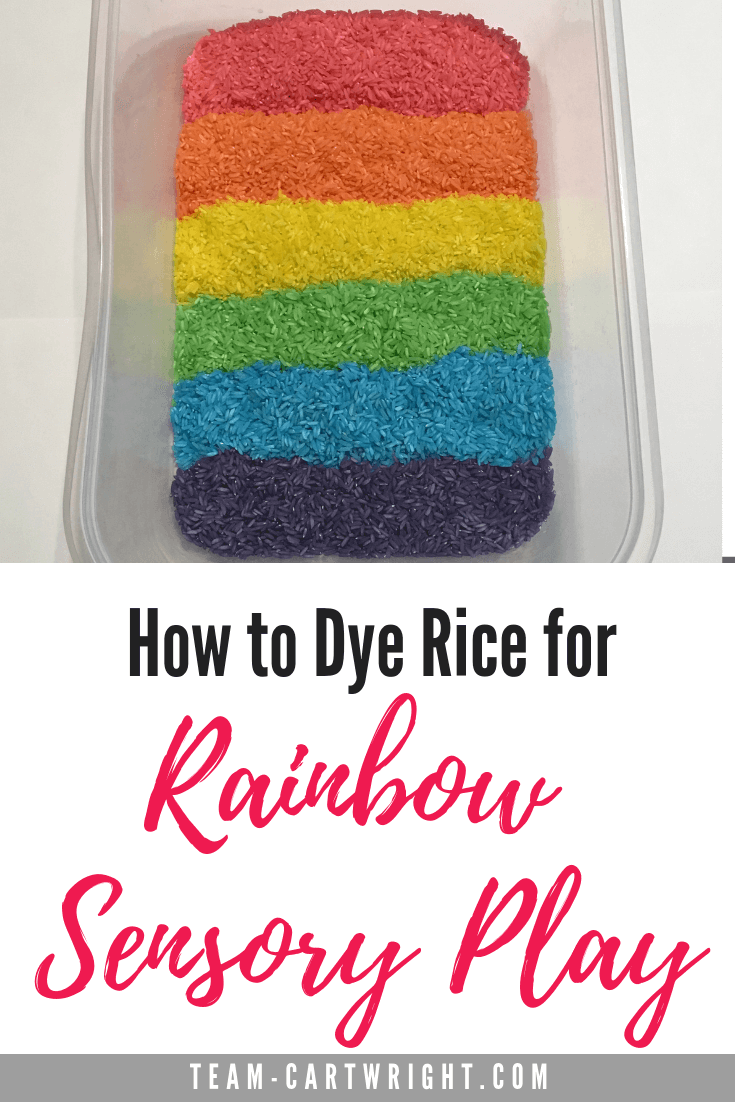Colored rice and other rainbow sensory bin ideas.
Sensory bins are an amazing way for kids to learn and just plain have fun. And there are so many kinds you can create!
One type of sensory bin my kids have really enjoyed is rainbow rice. So far they have only played with it at school and at the children’s museum. But I thought it could be a good one to have for at home play.
I was quite happy to find that it was super easy to make this colored rice at home. It took me less than 15 minutes to make it all. The only long part was letting it dry.
We didn’t want to stop there. Sensory play is too much fun and too valuable for children’s development. I found all sorts of easy ways to make rainbow sensory activities for my toddlers and preschooler.
Here is how to make easy colored rice and other fun rainbow sensory bin ideas to try. (And scroll down to print out the directions!)

This post contains affiliate links. Please see my disclosure for more info.
What's In This Post?
How To Make Colored Rice
This was so simple! It’s basically like dyeing Easter eggs. The recipe requires things I think most people have at home. At least they do in the small child phase of life.
You Need:
- White Rice (uncooked)
- Food Coloring
- Vinegar
- Sealable Baggies
How To Color Rice:
Measure out one cup of white rice and place it into a sealable baggie.
Add 1 teaspoon of vinegar.
Add the food coloring of your choosing. The more you put in, the brighter and more vibrant the result will be.
Seal your baggie and shake it up! This is a great way to include your kids in the dying rice process. Keep shaking and massaging the rice in the bag until you have an even color.
Spread the rice out on a paper towel or wax paper to dry. I let mine dry overnight, but it really only takes a couple of hours.
A note about the rice: You can buy a small bag, the bulk rice, whatever kind you like. Just don’t waste the fancy organic brown rice or other expensive stuff. Cheap, white rice works best.
Time To Play!
Once your rice has dried all the way it is ready to be sued for sensory fun!
I fully admit I lovingly arranged my rainbow rice by color in rainbow order, of course. (ROY G. BIV!) If you are like me and enjoy the beauty and order of something like this, take a picture. Once your kids have used this bin the colorful rice will forever be all mixed up. (A price I happily pay to see the smiles on my happy hooligans’ faces.
There are all kinds of learning activities you can do with this. You can talk about colors, compare volumes when pouring, and work on fine motor skills as they manipulate the rice. There is a lot to learn in your rainbow rice sensory activity!

Sensory Play Benefits
So how should your kids be using this type of bin? And why sensory activities at all?
Rice is excellent for scooping, transferring, and pouring. (Using measuring cups is perfect for this!) These are practical life skills.
Sensory bin play and sensory activities in general boost language developments, help kids understand their senses better and can boost social skills when they play together over a bin.
And sensory bins are great for all ages, from just a year old on up. (Keeping the materials age-appropriate in terms of safety, of course.) My kids love every sensory bin we have made.
Don’t think sensory play needs to be limited to bins like this. Sensory bins are great because you can set them up then step back and let your children have open-ended fun. But there are all kinds of sensory activities and crafts you can do with your children.
Learn more about the benefits of sensory play and get suggestions for non-bin activities here: The Big Benefits of Sensory Play and No Prep Activities to Try.
More Rainbow Sensory Bin Ideas
Rice isn’t the only way to create a colorful sensory experience for your little ones.
Pasta
Pasta can be dyed using the same method as the rice. Put one cup uncooked noodles into a baggie with one teaspoon vinegar and the food coloring of your choice.
I found the pasta doesn’t create as vibrant a color as the rice, mainly because the base pasta is yellowish. But you can make some interesting shades.
Water Beads
Water beads are just plain fun to play with. They are kind of squishy, the slip around each other, and the clear ones disappear in water.

You can buy this sort of bead at Target or other toy stores. You can also order Water Beads on Amazon.
Fake Snow
We love making fake snow. You only need two ingredients: baking soda and conditioner. Yep, the kind you use on your hair. You can keep the snow white, but adding in colors can make it really special. (And yes, it is actually cold like snow!)
We recently dyed our fake snow green to make Leprechaun Snow for St. Patrick’s Day. It was great. Learn how to make this fake snow in this post on Sensory STEM ideas: Sensory STEM for Toddlers and Preschoolers
Cereal Bins
We don’t use this bin very much. Too many pieces get eaten. But if you want a tasty treat grab some colorful cereal like Froot Loops.
You can limit the sugary stuff by putting down a base of plain Cheerios and then adding in the color stuff. This is a treat bin, a fun way to add some learning to dessert.
Anything Else Colorful
Seriously, you don’t have to overthink a sensory bin. Take a look around for anything colorful and plop it in a bin! Blocks, legos, tissue paper, puffballs. Anything you have can work.
If you have larger objects or just a small amount of colorful ones, start with a basic base. Dried beans, lentils, undyed rice, plain noodles. Use those as your main component and add in the rainbow items.
Head to the dollar store and find colorful items without spending a lot. Add food coloring to shaving cream for some messy play.
Your imagination is really the only thing limiting your sensory play ideas.
Sensory Bin Storage and Clean Up
There is no need to toss this rice after one playtime! You can use tupperware or cute bins to store your sensory components.
Personally, I use old rinsed out coffee cans. I know, it’s kind of old school. But why not reuse what you have?
The clean up for sensory play can actually be very easy. The key is in how you set it up.
I aim to do water play outside whenever possible, and rice is great outdoors too. Inside the house, I like to do our sensory play in the kitchen. The floor is easy to clean.
I also lay down towels or blankets underneath the sensory bin or sensory table before we play. That way any pieces that are too small to pick up are still easy to collect and take care of.
If you are planning something super messy, see if you can do it in the bathtub. It sounds funny, but little ones think playing in the tub is an adventure. It just adds to the experience and makes clean up much easier.
How To Make Rainbow Rice Free Printable Instructions

How To Make Rainbow Rice
How to make rainbow rice! Make beautiful and easy colored rice that is perfect for sensory bins.
Materials
- Uncooked Rice
- Vinegar
- Food Coloring
- Resealable Baggies
Instructions
- Add 1 cup of uncooked white rice to a sealable baggie.
- Add 1 teaspoon of vinegar to the baggie.
- Put several drops of the food coloring of your choice into the bag. (The more you add the brighter the color will be. Start with 5-7 drops for good coverage.)
- Seal the baggie and shake and mix it around until all the rice is colored.
- Open the baggie and empty the contents onto a tray or plate covered in paper towels. Spread the rice out to a thin layer.
- Let the rice dry. Once dry you can play with it!
Notes
Safety
This is a pretty safe activity. The materials are taste safe but do not let your kids eat or drink them. (They won't taste good.)
Storage
Once you are done playing with your rice, store it in an air-tight container until the next time you want to play. Rainbow rice can last a long time stored properly in a dry area, but check rice before you let your child play to make sure it is still good.
Tips
This rice is super easy to make, but it does take a few hours to dry. I recommend making it the night before you want to play with it.

Rainbow Sensory Fun!
You won’t regret having rainbow sensory play with your kids. It is an activity you can come back to over and over and it is so valuable for development.

Here’s more to check out!!
Monster Sensory Bags: Squishy Fun For Kids
Cutting Activities for Preschoolers
The Science of Slime and the Best (and Easiest) Homemade Recipes
5 Things To Know About Sensory Bins







